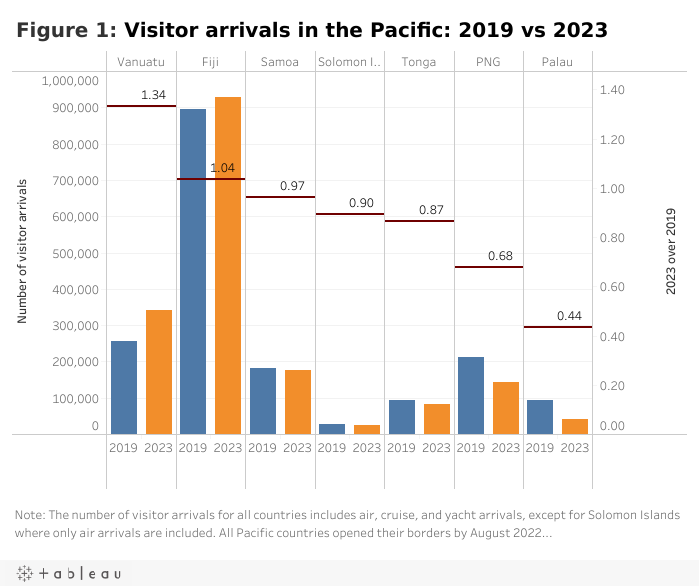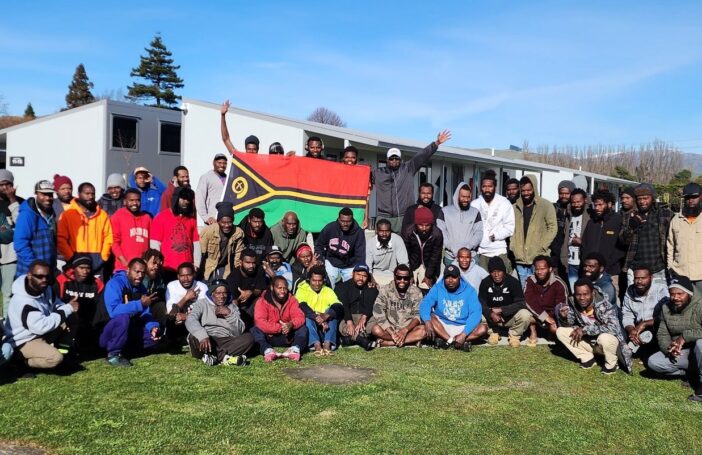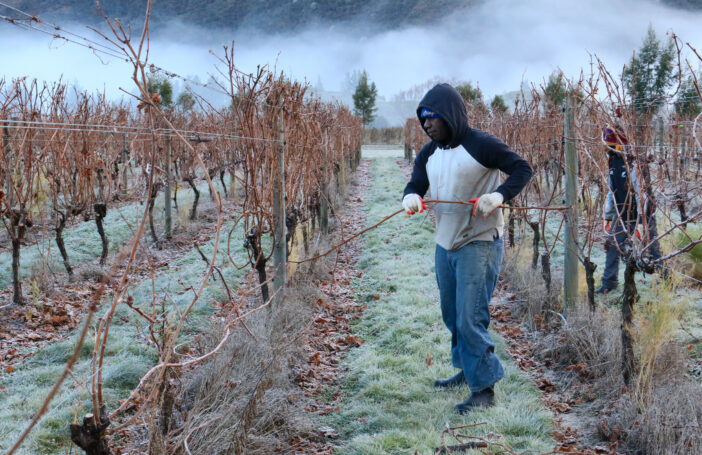As the pandemic recedes and gradually fades from people’s memories, travel in the Pacific is rebounding. However, the Pacific’s travel recovery is highly variable.
Comparing visitor arrivals in 2023 with those in 2019 (Figure 1 below), it looks like Vanuatu is the biggest winner, but this is misleading. Vanuatu has experienced a surge in cruise tourism, with the number of cruise arrivals nearly doubling from 2019 to 2023 and reaching more than three times the number of air arrivals in 2023. However, cruise tourism in Vanuatu has been “fickle and volatile”. It can strain limited labour resources and generates much less revenue than tourism by air. In 2019, though there were 40% more cruise tourists than air tourists, air tourists generated roughly nine times as much revenue. Meanwhile, Vanuatu’s air tourism arrivals have only recovered to 70% of their pre-COVID levels, with total air arrivals in 2023 at just 64% of 2019 levels.

Fiji has done well to achieve 4% growth from its already high pre-pandemic travel numbers. Holiday arrivals, which constituted over 70% of total arrivals in 2019, experienced a substantial increase of 12% over the same period. Other market segments are still lagging though, attracting only 82% of their pre-COVID visitor levels.
Samoa has also done well with 2023 arrivals only 3% below the 2019 level.
Solomon Islands and Tonga have visitor arrivals nearing but still significantly below pre-COVID levels, with recoveries of 90% and 87% respectively. Solomon Islands benefited from its hosting of the Pacific Games last year. If its November arrivals had been at the average level for the other months of the year, then its 2023 arrivals would have only been 70% of 2019 levels.
That leaves PNG and Palau. PNG is at only 68% of its pre-COVID air arrivals level, and Palau is struggling with just 44%.
To explain Palau’s poor performance, we need to look at the source countries. While visitor numbers from Australia and New Zealand to the region have fully rebounded to pre-COVID levels, visitors from Asian countries have been slow to return. Overall, the total number of visitors from Asia to the seven countries that we have data for has decreased by 44%, with Palau and Vanuatu experiencing particularly steep declines of 67% and 55% respectively. This downturn is particularly significant for Palau, where visitors from Asia accounted for 82% of total visitors in 2019. In contrast, other Pacific countries attract more visitors from Australia and New Zealand. In Fiji, there were 67,513 more Australian visitors in 2023 than 2019, which more than filled the gap left by a reduced number of tourists from Asia.
Papua New Guinea is a special case (see Figure 2). Its slow recovery is evident across all source countries and purposes of travel, with 2023 arrivals at 62% (business), 77% (employment), 64% (air tourism) and 61% (cruise tourism) of their 2019 levels. If we look at air arrivals only, 2023 volumes are back at 2007 or 2008 levels. 2007 was at the start of PNG’s air arrival boom, which ended in 2014. Air arrivals have been falling since, so this is not just about the pandemic. Flight disruptions due to fuel rationing, outbreaks of violence and riots, delayed resource projects and a generally depressed business environment have all deterred travellers.

Businesses, governments and NGOs learned to get by without travel during the pandemic, so it is perhaps not surprising that total travel has not fully recovered. And from a climate point of view, the less air travel the better. But the fall-off in air travel is problematic for the Pacific region if it means less tourism and depressed business conditions. From that point of view, there are some very worrying signs from this travel data for a number of economies, especially Palau, PNG and Vanuatu.





There is a really important conversation happening in the Pacific about what kind of tourism we want. This article reinforces the narrative that all that matters is visitor numbers. You allude to the difference in revenue per visitor in the case of Vanuatu, but it is more complicated than simply cruise ship vs air arrivals in terms of value to the economy, society, environment and culture. Given the importance of tourism to the region, I would love to see more Pacific-led research that starts from the perspective of questioning what success looks like in terms of tourism – and it is a lot more complicated that numbers – either in visitor arrivals or value to the economy.
An interesting article and an important topic to discuss.
In regard to PNG, a major issue you fail to mention is the astronomically high domestic airfare costs which is crippling both domestic tourism and businesses trying to operate here. It is literally cheaper to get an international flight to any other destination in the Pacific from Australia or New Zealand, than it is to buy a single one-way domestic ticket to most of the main centres in PNG. Just last month we saw Air Niugini announce a 15%-25% increase on economy fares, which only takes domestic fares to even greater heights. PNG has simply become a very expensive place to visit both for business and as a tourist.
This is all without even mentioning how unreliable air services have become in PNG. As both a tourist or a business worker there is a high chance your flight will be cancelled, resulting in you missing all your international connections and being left stranded for a week in a provincial centre (I can say this as it has happened to me on more than one occasion).
It is hard to see how PNG can lift the tourism industry when flights have become so expensive and unreliable….